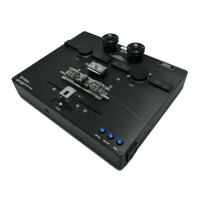FFS2000 Series Chapter 7: Splicing the Fiber
Page 50 TTN047338-D02
Problem Possible Cause Solution
Splice loss drops
instantly, then slowly
increases.
Filament power is too high. Run filament normalization. System will
automatically optimize power level and view-to-
splice distance.
Filament has aged. Run filament normalization. System will
automatically optimize power level and view-to-
splice distance.
Splice is not fully
fused, or loss does not
"bottom out".
Filament power is too low. Run filament normalization. System will
automatically optimize power level and view-to-
splice distance.
Splice time is too short. Increase the splice time in 0.5 s increments.
New filament installed without
carrying out filament
normalization.
Run filament normalization. System will
automatically optimize power level and view-to-
splice distance.
Bubble occurs at
splice.
Fiber ends did not meet properly
due to cleave defect.
Fiber ends did not meet properly
due to contamination on the fiber
ends.
Check the cleaver and adjust if necessary (refer
to Maintenance section for procedures).
Inspect fiber end for dirt/debris. Remove
dirt/debris by using the cleaning station or re-
cleave fiber. (Note: Clean cleaver blade with Q-
Tip and acetone prior to re-cleaving. See
Maintenance section.)
Neckdown occurs at
splice. (Fibers are
fused but the point of
the splice is narrower
than the normal fiber
diameter.)
Fiber ends were not touching
during the hot-push.
The right hand fiber did not push sufficiently
because the strip length was incorrect and the
shoulder of the primary coating butted the end
of the Graphite, or the fiber gap was incorrect
due to a poor cleave, or the FHB hit a software
or hardware limit.
Bulge occurs at splice.
Hot Push distance too high. Decrease the Hot Push distance.
Fiber ends bubble
apart in “q-tip” splice.
Fiber ends too far apart prior to
the Hot Push.
Increase the Pre-Push distance by 2 µm
increments, but do not exceed 16 µm total pre-
push.
Filament power is too high. Run filament normalization. System will
automatically optimize power level and view-to-
splice distance.

